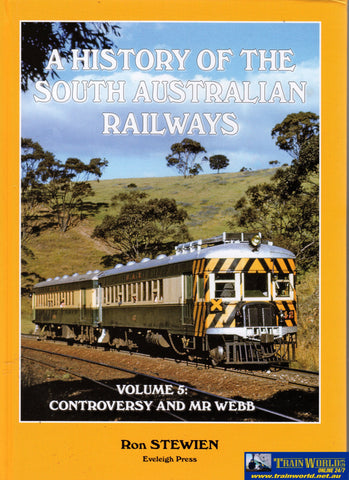A History of the South Australian Railways Volume #05: Controversy and Mr. Webb (ASCR-SAR5)
Product No.: ASCR-SAR5
Title: A History of the South Australian Railways Volume #05: Controversy and Mr. Webb
Author(s): Stewien, Ron
Illustrator(s): N/A
Publisher: Eveleigh Press
ISBN: 9781876568610
Condition: New
Binding: Laminated Pictorial Boards
Dust Jacket: None
Edition: 1st Edition
Publication Year: 2011
Features: 240 Pages with Colour & Black/White Photos.
For the South Australian Government and their state-owned railways, the second decade of the twentieth century ushered in a constant and intense turmoil. Parliament was in disarray - between June 1909 and April 1920, the Labor and Liberal Parties alternated in government five times.
On three separate occasions, Archibald Henry Peake managed to form a Liberal government. 'Opposing views' were rampant! Between them, the various Governments, created the Anthony Commission and a Royal Commission, to investigate current railway practices. And, a Parliamentary Standing Committee on Railways was created to appraise some of the more hare-brained railway routes being proposed. Some of the findings and recommendations of these various groups were in themselves quite controversial. But, to satisfy one of their recommendations, the third decade saw the appointment of a 'Chief' Commissioner from overseas to rehabilitate the railways.
From the USA, came William Alfred Webb, who was controversially chosen to fill out this role. His appointment and his subsequent management decisions led to 'opposing views' of even greater proportions than was seen in the second decade.
Volume 6 in this series saw the introduction of forty-five new steam locomotives and three Wrecking Cranes. Volume 5 now goes back to the appointment of Webb and his rehabilitation of the SAR. He introduced into South Australia one of the largest fleet of Brill internal combustion passenger railcars in the World and a fleet of bogie freight rolling stock just like "at home ". He also intended to introduce a new fleet of locomotive hauled passenger cars but apart from a Pullman dining car and two Pullman sleeping cars for the Melbourne Express these plans had to wait.
He built a new Adelaide Railway station that looked like Buckingham Palace, which politicians mockingly branded 'Webb's Palace'. One of his most monumental feats was to convert the Islington Workshops into a world standard manufactory that could make almost anything. During the Second World War they did! He built new roundhouses, turntables and coaling plants to serve his new giant locomotives. He replaced or strengthened most of the railway bridges in the state to take the heavier trains. He fought road competition with his own fleet of buses and trucks only to have them stripped off him by meddling politicians. And he wrought administrative changes along the lines of American railroads that the politicians also didn't like. Ron Stewien covers all of these in Volume 5 with 240 pages packed to the hilt with information.
The book includes 170 photographs, 16 in colour, and 154 in monotone (one in sepia). There are 25 rolling stock diagrams and 21 other diagrams (including a train control graph). Two gatefolds display plans and photographs of the Pullman cars in the way such historic vehicles should be viewed. A list of references and further reading follow the Appendices. A comprehensive Index winds up the back of the book before a few notes on the author.



